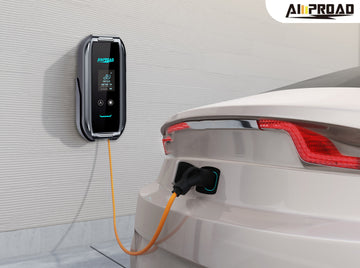
The era of electric vehicles is coming, and more and more electric vehicles can be seen on the roads in the United States. The biggest problem with electric vehicles is undoubtedly the issue of battery life and charging. Installing a home EV charger can solve this problem very well.
In North America, electric vehicles can be divided into two main categories: Tesla and non-Tesla. Non-Tesla models consist mainly of electric vehicles from traditional car manufacturers such as Chevrolet, Ford, and Volkswagen. They follow the SAE J1772 standard and use the Common Charging System (CCS). Tesla, on the other hand, has a proprietary charging port (just like the iPhone used to charge through Apple's unique Lightning port, while Android phones all used Type-C ports).
When it comes to purchasing a home EV charger, there are several important factors to consider. Here are some tips to help you make an informed decision:
- Maximum Current Rating: Look for a home EV charger with a maximum current rating of at least 32A. To provide the fastest possible home charging, Level 2 EV chargers run on a 240-volt circuit, delivering 16 to 80 amps to your vehicle. Since most electric vehicles come with a portable EV charger (Level 1 or slow EV charger) capable of slow charging from a standard 120-volt socket, a suitable home EV charger would ideally have a rating of no less than 32 amps to ensure efficient charging.
- Cable Length: Choose a home EV charger with a cable that is at least 20 feet long. Although longer cables tend to be thicker and more inconvenient than shorter ones, a long cable is crucial to ensure it reaches your vehicle's charging port. A typical two-car garage is 20 to 24 feet wide, so it's not recommended to buy any EV charger with a cable shorter than 20 feet. The National Electrical Code (NEC), established by the National Fire Protection Association (NFPA), has an upper limit of 25 feet for EV charging cables.
- Plug Type or Hardwiring: Look for a home EV charger that either has a NEMA 14-50 plug or can be hardwired. Generally speaking, hardwiring is preferable to plug-in installation because it creates a more seamless (and therefore more energy-efficient) connection between your home's wiring and the EV charger. Hardwiring also provides greater protection from outside influences (critical if you plan to install the Level 2 EV charger outdoors) and can deliver 15A to 60A to your vehicle, while a NEMA 14-50 EV charger connection can only handle 15A to 50A. Since everyone's life circumstances and needs are different, it's best to have both installation options available.
- Nationally Recognized Laboratory (NRTL) Certification: Ensure that the home EV charger you choose has approval issued by a Nationally Recognized Testing Laboratory (NRTL) such as Underwriters Laboratories (UL), Intertek Electrical Testing Laboratory (ETL), or any other testing agency recognized by the U.S. Department of Labor's Occupational Safety and Health Administration (OSHA). This seal indicates that the product meets strict safety and compliance standards.
- Warranty: Look for a home EV charger with a warranty of no less than one year. A one-year warranty is sufficient to ensure that you can charge regularly and confirm that it's not a defective product. However, a longer warranty would be even better in case parts break or the EV charger fails unexpectedly.
- Outdoor Use Compatibility: If you typically park your car in a carport or other outdoor parking space, you'll want to make sure your home EV charger is protected from dust, rain, and other harsh conditions. Even if you plan to place the charger in a closed garage, it will still be exposed to the air to a lesser extent when the door is open. It's recommended to prioritize home EV chargers with stronger intrusion protection (IP) or National Electrical Manufacturers Association (NEMA) ratings (two common ratings of weatherproofing), as well as those that can withstand more extreme temperatures.
In addition to home EV chargers, it's important to understand the different charging options available for electric vehicle owners. For Tesla owners, the Tesla Destination Charger is a convenient option when traveling or visiting certain locations. These chargers are installed at various destinations, such as hotels, restaurants, and shopping centers, and provide a charging solution for Tesla vehicles. They are typically slower than the company's Supercharger network but can still provide a decent charge while you're stopped at a location for an extended period.
For non-Tesla electric vehicles, many public charging stations are available, including Level 2 and DC fast chargers. Level 2 chargers are similar to home EV chargers but are designed for public use, while DC fast chargers can provide a significantly faster charge, though they are typically more expensive to use.
It's also worth mentioning portable EV chargers, which can be a useful backup option or a solution for those who cannot install a dedicated home EV charger. These compact and lightweight chargers can be plugged into a standard 120-volt outlet, providing a slower but still useful charge when needed. While not as convenient as a dedicated home EV charger, portable EV chargers can be a valuable addition to an electric vehicle owner's charging toolkit.
When it comes to choosing the best home EV charger, the Amproad iFlow P9 EV Charger stands out as an excellent option that meets the criteria mentioned above. This Level 2 EV charger is adjustable from 10A to 16A, 24A, 32A, and 40A, ensuring compatibility with a wide range of electric vehicles and providing efficient charging speeds.
One of the standout features of the Amproad iFlow P9 is its 25-foot-long cable, which exceeds the recommended minimum length and ensures that you can easily reach your vehicle's charging port, even in larger garages or parking spaces. Additionally, it features the industry-standard SAE J1772 plug with a NEMA 14-50 connection, offering the option for either plug-in or hardwired installation, depending on your preference and needs.
Safety is a top priority for the Amproad iFlow P9, with robust leakage protection and high-temperature protection features. This ensures that the charger can be used safely outdoors, as it is designed to withstand harsh conditions, including dust, rain, and extreme temperatures. Furthermore, the charger is certified by Nationally Recognized Testing Laboratories, meeting strict safety and compliance standards.
In terms of warranty, the Amproad iFlow P9 EV Charger comes with a one-year warranty, providing peace of mind and protection against defects or unexpected failures during the first year of use. However, Amproad is known for its commitment to quality and customer satisfaction, so you can expect reliable performance and longevity from this home EV charger.
As the adoption of electric vehicles continues to grow, having a reliable and efficient home EV charger is becoming increasingly important for owners. By considering factors such as maximum current rating, cable length, plug type or hardwiring, certification, warranty, and outdoor compatibility, you can make an informed decision and choose a home EV charger that meets your specific needs and provides a seamless charging experience.
Whether you're a Tesla owner taking advantage of the Destination Charger network or a non-Tesla electric vehicle owner relying on public charging stations and portable EV chargers, having a dedicated home EV charger like the Amproad iFlow P9 can offer unparalleled convenience and peace of mind. With its advanced features, safety certifications, and commitment to quality, the Amproad iFlow P9 EV Charger is a top choice for anyone looking to embrace the future of electric mobility while ensuring a reliable and efficient charging solution at home.


